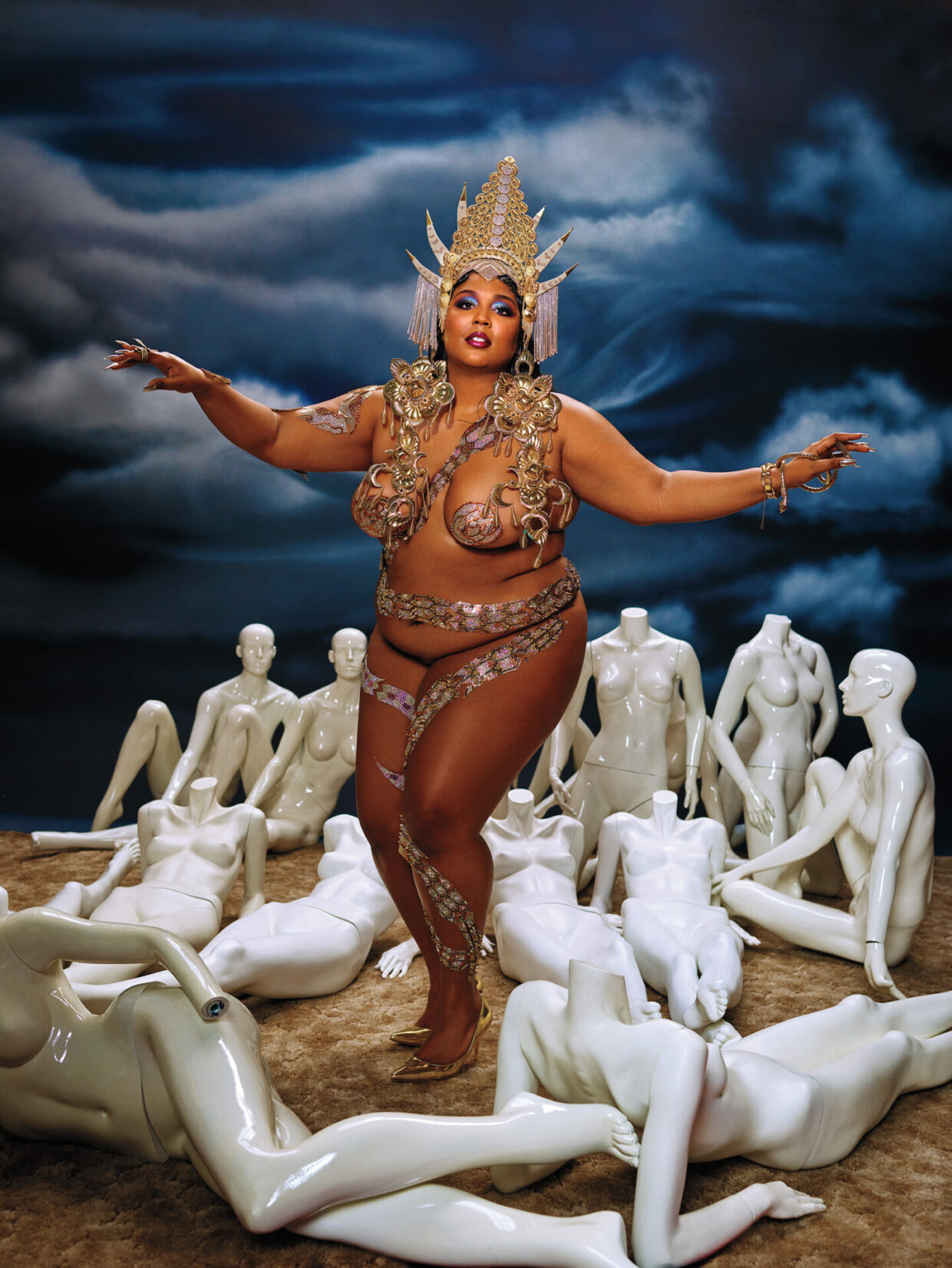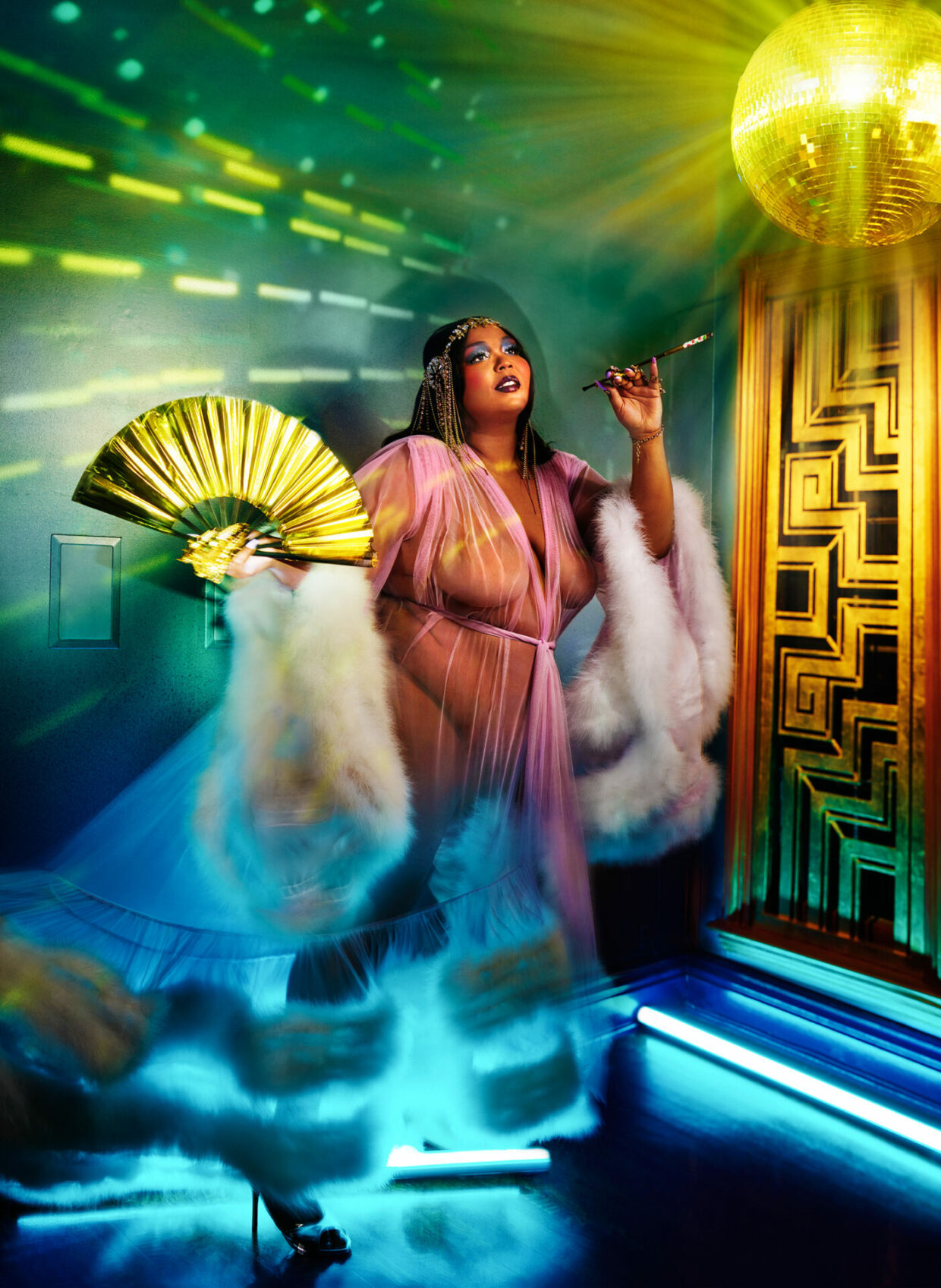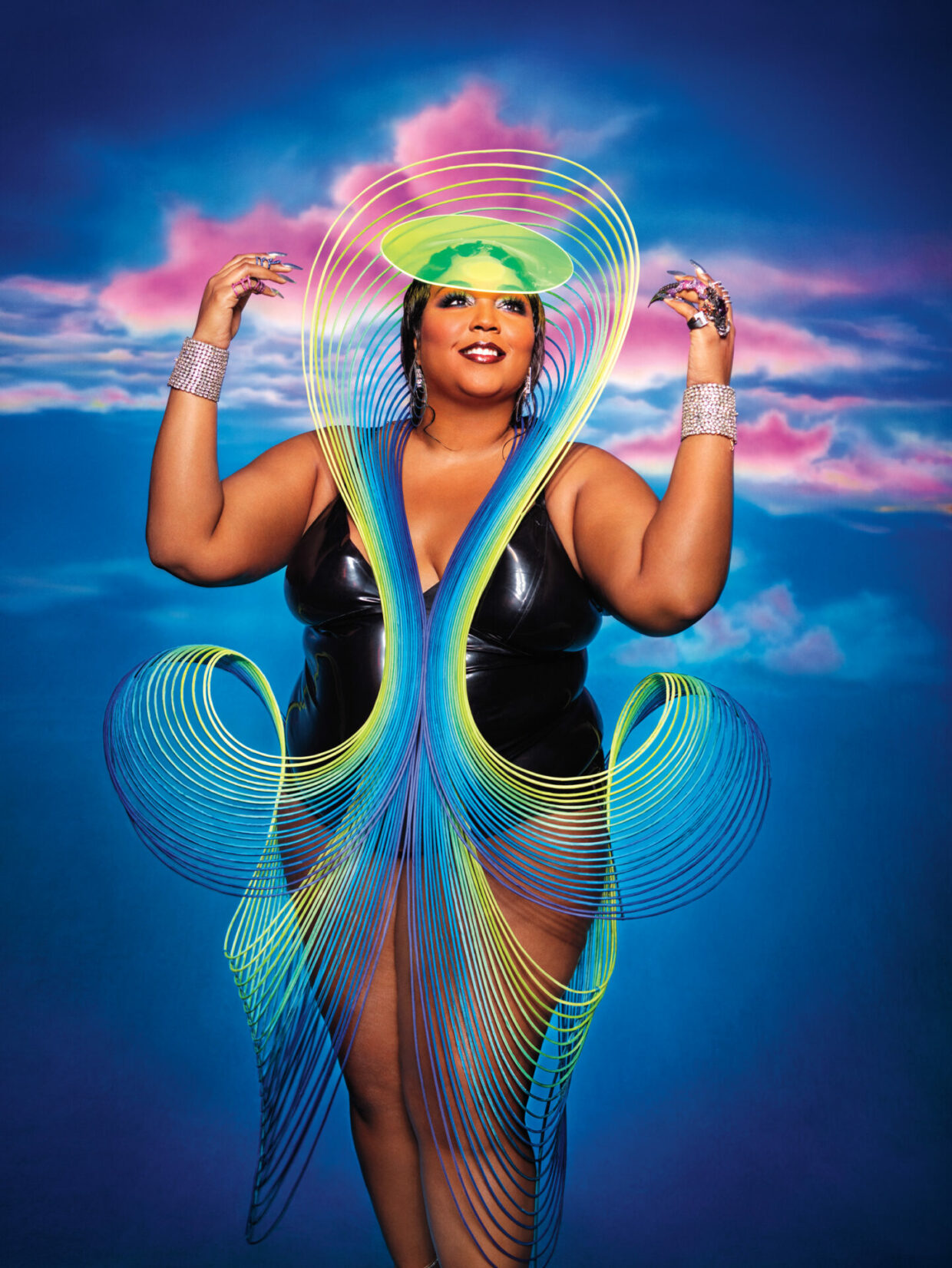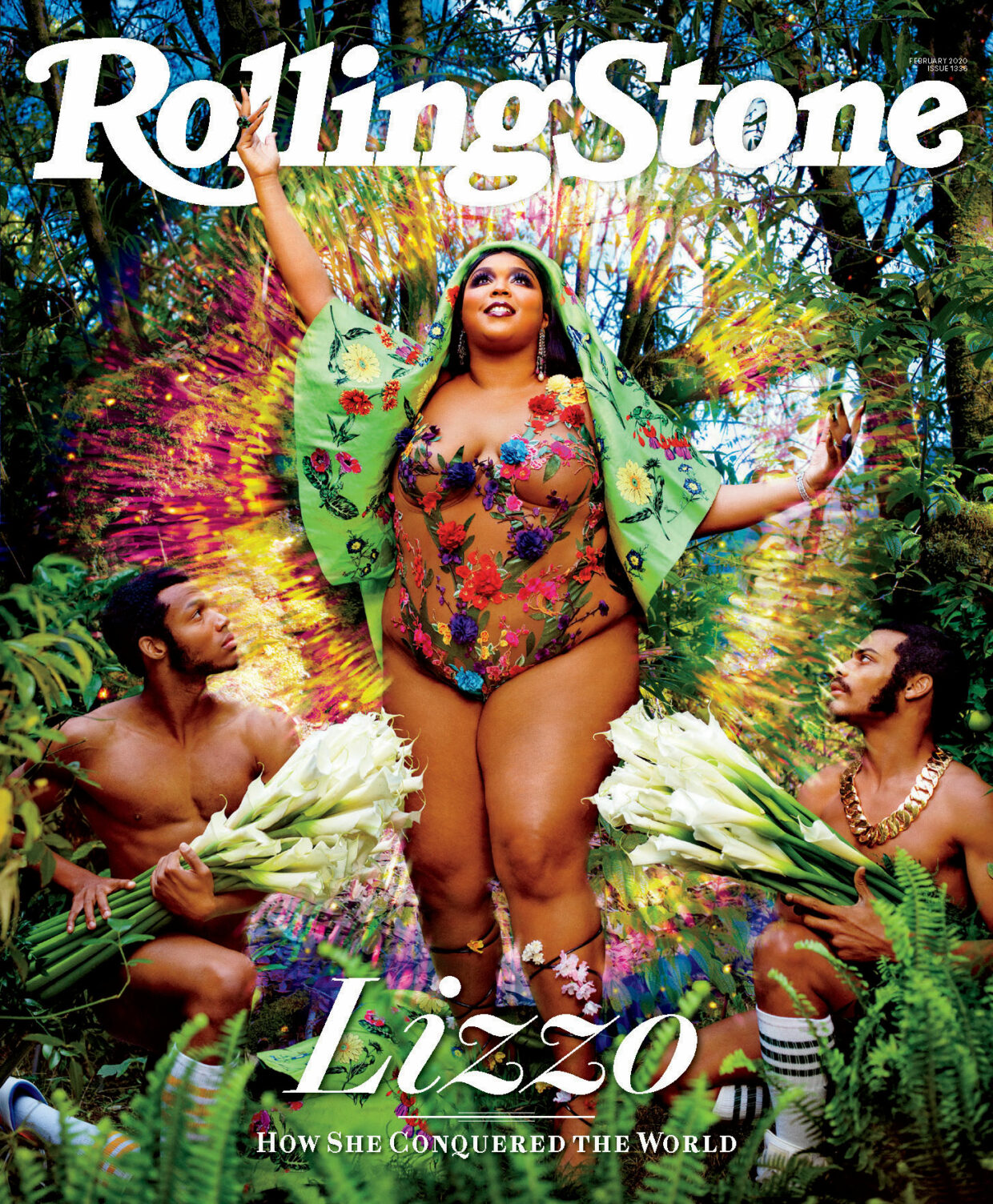David LaChapelle Explains His Inspiration for the Lizzo ‘Rolling Stone’ Cover Shoot
Jan. 23, 2020
By: Claire Shaffer
Lizzo graces the pages of Rolling Stone’s February issue with a gorgeous set of photographs by David LaChapelle. The Hawaii-based photographer and artist first cut his teeth working for Andy Warhol’s Interview magazine in the 1980s, and has since risen to become a major figure in the art world for his nontraditional celebrity photo shoots, appearing in Rolling Stone and other national magazines for the past three decades.
LaChapelle’s colorful, eye-popping works pull from religious iconography, surrealism, and the apocalypse. If read in the most cynical way, they can highlight the more unsavory elements of their famous subjects. But LaChapelle is rarely cynical about whom he photographs, and he says this shoot in particular was about melding the “fun and wholesome” aspects of his work to Lizzo’s persona. In fact, Lizzo’s creative director, Quinn Wilson, has said that for the pop star’s earliest examples of styling and single art, her team took inspiration from the photographer.
“I think aesthetically and referencewise, I always looked to David LaChapelle,” Wilson told Rolling Stone on the set of Lizzo’s cover shoot in Los Angeles. “During one of the shoots I started tearing up, because it’s so incredible to have made work that in some way — even if it’s just, like, a little tiny smidge of color, or just a tiny bit of influence of him that’s included in our work — we’re now seeing the actual creator of that with her. She’s in front of his lens. That is a moment where I’m like, ‘We did our job, we did our job well.’”
Wilson added that Lizzo must have sparked something in LaChapelle since, “He doesn’t need the gig,” she said with a laugh. Since moving his base of work from Los Angeles to his current island abode some 14 years ago, LaChapelle has largely stayed away from celebrity photography, focusing instead on fine artwork and the occasional dance film. He released what he has said would be his final book collections, Lost + Found, Part I and Good News, Part II, in 2018, featuring surreal and often risqué images of Tupac Shakur, David Bowie, Whitney Houston, Keith Richards, Kanye West, Miley Cyrus, and many others.
On a recent phone call from his home in Maui, LaChapelle chatted with Rolling Stone about working with Lizzo and the style inspiration behind the cover shoot.
What first drew you to Lizzo and made you want to work with her?
A friend played me a song by her; I’m out here in Hawaii, so I’m a little bit out of the loop. Listening to Stevie Wonder. [Laughs.] Every once in a while, there’ll be a song that kind of just like blows you away, and we were doing a shoot out here, and my friend put on [singing “Good as Hell”]: “I do my hair toss. Check my nails. Baby, how you doing? I’m feeling good.”
I mean, that is the catchiest song ever released. It’s so joyful and full of light, and we were all dancing around and just blasting the speakers in the jungle. So great. I loved it, and then I kind of forgot about it. And then I was watching something on YouTube, and I think my algorithms are kind of like … I love Chaka and Aretha, and so they sent me some video snippet of her. And I was like, “Wait, that’s the girl.” She’s doing her thing, singing and rapping, and then she whips out this flute, and I was like, “What the fuck?” Anytime someone can play an instrument, to me, that’s just magical. That is like the girl in band class sitting in the back. That’s the girl that I would’ve forced to be my best friend in high school. She’s just wailing on this flute, and I was like, “OK, this has to happen. I want to photograph her.” And that was that. I had to.
What was the theme of the shoot, going into it? Because it seems like you had a palette in mind.
I did. I had a palette, and I worked closely with my stylist Brett Nelson. My style is to talk about exactly the color and fabric I want. And what encouraged me about Lizzo was … we didn’t speak much on the phone or anything prior; I think we had a short conversation. But she was like, “Oh, I’m getting my rest, and I have nothing to do that entire day. I’m just going to be there all day, and I’m going to sleep. I’m going to get all my sleep the night before.” And that’s a really good sign — when an artist is blowing up like that, and they’re still going to go to bed early the night before and will devote the whole day to the shoot. That’s, like, back in the day when I would shoot those great shoots with, like, Lil Kim. I mean, one time I did a shoot for 22 hours, no drugs involved. We had a DJ who just played for us and just keep us going all night. That was in New York. We were blasting music so loud at night that this can of Goya beans came through the window; my neighbor’s way of saying, “Could you please turn the music down?”
Those were the best shoots, and then you get these other people that are like, “I have from 12 to 4, and then I have another appointment.” I don’t want to work that way. This is a collaboration, and we go full out, and it ends when it ends, or we don’t do it. I’m not just going to bang something out. And I don’t want to be pressured at this point. Things can only flow and good stuff can only happen when you don’t got that intense time limit.
Were you intentional about the order that you shot the photographs in?
Yeah, I plan my day around a couple things. First up there’s logistics: We went from my studio to my house back to the studio. So there had to be an order of shots. And limited daylight. I wanted to be in the garden at a certain point, and then that blue room is in the house. And so I had to figure out that.
But also, I typically want to start shooting with shots that are powerful, but also easy, in terms of me knowing that it’s going to work. You want to get this flow going and get everyone excited, kind of set the tone and get on a roll and everyone gets juiced up. And then, as soon as you get that first one off and it’s not painstaking, and you know this one is kind of a bang, then it really makes the rest of the day easy because you already know that you’ve got this great shot.
There’s a lot of different eras of music and style in this shoot. On the one hand, it’s very disco-oriented, Seventies, and a little bit of Studio 54, but there’s also a bit of Egyptian by way of the Roaring Twenties. How did you choose those particular time periods for Lizzo?
I originally bought the house [where we shot] for my mom to live closer to me in Los Angeles, but she didn’t really get to live there very long. She passed away, so I sold my place and I moved into that house, and my mom had this master bedroom that was kind of weird, and I said, “Let’s turn it into a nightclub for my friends.” I had my friend Kristin Valor, who’s an art director, design the space. The inspiration was a brothel bordello from Harlem in the Prohibition era that was inspired by … at that time what they would call it “Orientalism,” because back then Orientalism was anything Egyptian or Chinese or Japanese. They’d had the Egyptian revival movement. And there was an art deco thing to it as well.
We asked, “What would this bordello look like, and what would this speakeasy look like?” And so we just did it so that I’d have this place, because I don’t really go out in L.A. I bring my friends over and we just play music — not a lot, maybe once a month — or hang out in there weekly as a place to go and play music and smoke and do the occasional mushroom or whatever, but that’s as hard as it gets.
But it’s just this beautiful room that we used, and I worked with my scenic painter, and he did the silver wall, and he overlaid that with this ombre of blues to greens. And then he did a mural on the ceiling, which you can’t really see, but it’s clouds, and we spent a lot of time making this room. We always want to feel like we want to live in one of my sets. You know, “God, I want to live in this set!”
So we did that with that room that we took from my mom’s master bedroom. And it’s a really happy place cause nothing dark happens in there. It’s not like a cocaine den or something. It’s a really happy place where only really good friends that I consider family hang out. We just listen to that Minnie Riperton song. [Laughs.] We’ll take turns telling Siri what to play. It’s really fun and it’s wholesome.
Right, the Minnie Riperton song “Les Fleurs.” You were playing that a lot during the Lizzo shoot?
I love that song. I never get tired of it. My friend Daphne Guinness, she was the first one to play it for me. And I was on mushrooms. Two years ago. And I never heard anything like it ever. I just thought, “It’s such a cool song, I didn’t know Minnie Riperton made a song like that.” It sounds like a Broadway musical or something; it just builds and builds and builds into this super crescendo.
Let’s talk about the backgrounds as well. Were those cloud paintings in your studio already, or did you make them specifically for the shoot?
That cloud painting I had. Tom Hall, my scenic designer, made them. Tom also painted that room in the house that wound up as the blue room for the shoot. That worked really great. I love brush art like that. I started doing brush art with Ernie Valdez, who was in that film Style Wars, which is a seminal documentary on graffiti art in the late Seventies and early Eighties, and he’s actually in that film along with the great legends of graffiti art.
I love the look of brush art because I want every photograph to look like an album cover. Album cover–worthy. That idea had such a huge impact on me as a kid — you’d listen to a record and look at every little detail on the cover. We didn’t have videos or anything back then, so we would just sit there and stare at these album covers, and some of this album cover art was incredible. I loved Tadanori Yoko, who did Santana’s album covers. This legendary Japanese pop artist. He wound up doing the first cover of my book. I love album cover art, and airbrush, and silkscreen, and melting cherries. And it’s harder to find those guys now.
You actually included a Grace Jones single cover in the background of one of the photos.
Well, that’s like three of my favorite artists in one. First, that’s Grace Jones. But that’s also Jean-Paul Goude — who was her boyfriend, lover, baby daddy — who art-directed all her shows and even her haircuts and everything. He was an incredible photographer, and he shot that photo.
And then Richard Bernstein, who did her covers, he was great. Richard Bernstein did all the covers of Interview magazine, where I started out. He would paint airbrush and use colored pencils on top of photographs for Interview. I loved Richard Bernstein’s covers because they just stood out on the newsstand so much. Everybody was always waiting for the new Interview to come out. It was kind of like the internet today, you know what I mean? It was kind of like scrolling the internet.
So, yeah, three of my favorites in one cover: Richard Bernstein did the cover of that album, Jean-Paul Goude did the photo, and Grace Jones was the subject.
And I remember first hearing Grace Jones when I first started going to gay bars at 14 and stuff, and it’s like … you’d find girls like Lizzo at those clubs. That’s what I love about Lizzo. Her music is sort of escapist and happy, and I was really drawn to her for that joy that she’s got. She is the kind of girl that I would have gravitated to in high school and been like, “You are going to be my friend. You don’t really have a choice in the matter. We’re going to go out to the gay bar and dance together, and that’s what’s going to happen with us.”
Did she give off that impression when you met her?
Yeah, she really was what I was hoping. I kind of thought about her beforehand like, “Oh, I hope she’s fun and happy and laughing,” and man, she was all of the above, and just so cool to work with. We spoke in the back after the shoot, and she was lovely, just talking about a lot of other artists. I was touched by that, because she’s not competitive in that way. She’s like, “There’s room for everyone.” I’d be asking her questions, and she’d be like, “Yeah, but I want to hear about you. Tell me how did this all start?” She’s really curious about other people as well and she just seems so genuine. I kind of fell in love with her, for sure.
For the costumes, did you reach out to designers for any specific pieces ahead of time?
Yeah. Brett knows what I like and he comes up with stuff that I would never even have thought of. And he knows everyone, from the big labels to the girl who’s in a basement in Antwerp making really cool things. He’s just really hooked up in that sense. And what I love about Brett is that he can do costume and also knows fashion, and that’s a really rare combination [for a] person who can have things made. He knows his way around creating costumes, but also knows fashion. I remember back when I first started working in L.A. a long time ago, it was hard to find good stylists out there — in New York and London, I was working with Isabella Blow and working with other really great stylists. And then I wound up in L.A., and it was like a stylist would show up with just a rack from Barneys of little black cocktail dresses.
But things have really changed in L.A., so now there’s some really talented people. But a good stylist is really hard: The whole team, everyone, every link in that team’s got to be strong. And Lizzo had a great team, too. Her hair and makeup were superstrong. It was a good group.
I wanted to ask about our cover photo — that’s your actual backyard, right?
Yeah. The last thing I shot there was for Elton John’s farewell tour, the picture of Elton with the piano — he’s standing back there, and it’s like this disheveled garden is all overgrown with wild roses. I don’t trim the grass or anything. My neighbors don’t really like that. But it’s a set, you know, kind of like there’s this set growing in my backyard. I shoot there and I love it.
How did you create that lighting effect around her?
Oh, the glow? That’s a technique I started. I started this technique in the Eighties in a dark room, painting on negatives in opposite colors. And so I just employ that technique to the picture. I didn’t even think … well, I didn’t know if Rolling Stone was even going to like it, let alone use it as the cover, but it gives this stained-glass kind of glow and radiance to the photo. You’re working with opposite colors, so you don’t quite know exactly what they’re going to come out like when they mix.
I used to do my own color printing like this for 10 years in New York City. And I experimented a lot, and I started painting on negatives with the opposite color: this photo dye. In fact, back then it was, like, 35-millimeter negatives, and I would just go in with these tiny little brushstrokes and it would be like gigantic blobs, you know, depending on how big you blew up the print. And so I started doing that again five or six years ago.
I thought this one was cool. Mary, the Madonna, is kind of like … just this beautiful woman in God’s garden on earth. This sort of Eden kind of setting. That kind of idea. Goddess, you know?
What’s the story behind the nighttime shoot, with the car?
That’s my dad’s car. I wanted to be like Elvis and buy my mama a Cadillac, and I did. So then I said, “Mom, can I have Dad’s car?” My dad had died as a kid, and my mom was living in Florida at the time. I said, “I’m going to send a truck to pick up Dad’s car,” which was in mint condition. It’s like a classic, and my parents took care of everything so perfectly. There’s still these towels in the car from the Eighties — my mom would wash and put in these gray towels that matched to keep the leather interior nice. Anyways, I put that car in the shoot, and that was just the car that I drove to work that day, and it was my dad’s car. Isn’t that cool?
And that’s in front of my studio, and that’s in the alleyway. And for the models, we wanted a lot of movement in front of the phone booth. Back in the day we used to have to wait for phone booths — I remember somebody asked me, did you like life better before or after cellphones? And I’d sort of been thinking about it, and I remember living on 3rd Street between Avenues A and B [in New York] for a long time and having to go and wait for this pay phone, and there was one Puerto Rican girl that would never get off the phone and she always happened to be there in front of me. Sometimes arguing, or just canoodling on the phone with her boyfriend, and I’d pretend not to be enraged at how long I had to wait, but yeah. Those guys in the photo are waiting for her to get off the phone. And they’re like, “Finally, that girl’s off the phone.”
You’re staging that scene with them.
I just wanted them moving back and forth. I’m like, “OK, you need to get on the phone,” and she’s finally coming out of the booth, and she’s happy.
Were there any shoots you had to convince Lizzo to do?
No.
She was game for anything.
Yep. I have so many more ideas now, though. Gosh, too many more ideas. But she was just a great model, kind of the perfect subject. We were both into what we were doing, and she felt it. I felt it, and the team felt it. I just wanted her to look good and just make album cover art, and she was down for that.
You did an interview with us a couple years ago and one quote really stuck out to me. You said, “I feel that musicians have always given more to the world than the world gives back to them.… You shoot artists at the beginning of their career for the cover of Rolling Stone and then see them years later and they have the weight of the world on them. That’s that pressure to stay relevant, to keep the Number Ones coming.” Since you’re working with Lizzo just as her career is taking off, I’m wondering what your hopes are for her in the future.
I pray that she is strong enough to handle the evil that’s out there. There is a lot of dark, evil shit being said. I read some Instagram comments on her photos, and I just was like, “Oh, my God.” My heart just went out to her. I got bullied in high school, and I don’t know her story about high school, or whether she was bullied or not or whatever. But I pray for Lizzo to just have good people around her that will shield her from that commentary.
Sometimes when you’re an artist you think that the one person saying that you suck is actually telling the truth, and that the people saying “I love you” are just being nice. You see there’ll be 50 people saying I love you, you’re my favorite, whatever, and you have that one person that says you suck for these reasons. And you’re like “Oh, that one person’s telling the truth and the rest of the people were being polite. That one person’s being honest.”
But actually, it’s the opposite. That one person is probably jealous. The other people probably really do truly love you. They really love you. You’re making them happy, and they are digging your music or your photos or your artwork really deeply. And they may only express it with a heart or “love you” because that’s all they can say. But they’re actually being real.
Source: Rolling Stone




